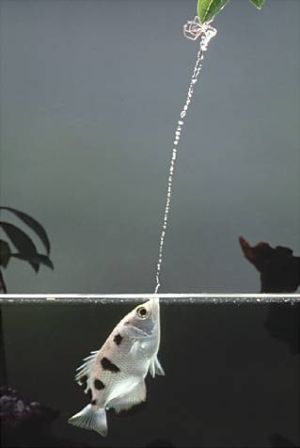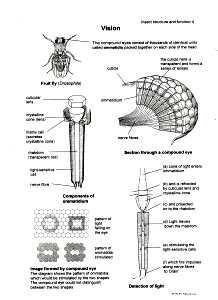I've put up some amazing things, but this is certainly one of the highest ranking. Judge for yourself.
The fig tree has a tightly closed inflorescence, which means that the hundreds of tiny flowers (florets to give them their proper name) are completely inclosed inside the fig. They can't be seen from the outside.

Each species of fig seems to be pollinated by only ONE species of wasp! There are about 730 species of fig so that would seem to require 730 species of wasp- but not all of these are known as yet.
How do the insects find the flowers?
When the tree is ready for pollination, it releases tree-specific volatile substances which the wasp tracks down to their source. Lo and behold, there's the flower, or the inflorescence, rather.
So the female finds the inflorescence. Thousands die in the search process though, because it's a big world out there.
How do they get in?
When she finds it, there is another big hurdle to cross. The entrance to the inflorescence (called the ostiole) is extremely small, and lined with bracts, which are placed there to keep out the unwanted. They fit tightly, and that makes life very difficult for the unwanted, but no less so for the wasp, to get in.
She, however, has been explicitly designed for this very task.
Her head and thorax (chest) are extremely flattened and elongated: just the job for squeezing past the bracts! ('Remarkably adapted' is the description. Ho ho ho!) Her 'teeth', on her mandibular apparatus, point backwards, and she's got teeth on her hind legs, also pointing backwards. They do so in order to prevent her from slipping out!

Her wings very often break off in the struggle to get in - so once in there, there's no way back.
Once inside, she sets about, in complete or nearly complete darkness, to pollinate the stigmas, and to lay eggs in some of the ovules. She distinguishes between those ovules which are going to become seeds, and those which are not.
Those ovules whose styles are too long for her ovipositor to reach the ovule, she simply pollinates.
Those ovules her ovipositor can reach, she leaves unpollinated, so they will only contain her larvae.
This makes certain that the plant will survive, and that her larvae will have food to eat.
What happens then? She dies. Her young never see her alive, and can't copy her actions - but they do exactly the same as she did.
As the eggs develop and hatch out into larvae, the eat the endosperm of the ovules they have been laid in, and they grow into adulthood.
The males mate with the females, and amazingly, chew a hole in the wall of the maturing or matured fig SO THAT THE FEMALES CAN GET OUT.
Then they die.
The females in the meantime, load up with pollen, or get covered in it, and then set off to find another flower inflorescence.
EVOLUTIONARY DIFFICULTIES
1 How do we explain the fact that the young never see the adult in action - and yet they do exactly the same as she does?
2 How do the males know that unless they dig a hole, the females won't get out, the plants won't get pollinated, and their own species will die out?
3 How is it that only the fig wasp pollinates the fig flowers? Without the wasp, as with the bucket orchid, the fig will die out, and without the fig, the wasp will die out?
4 How did the female 'develop' the elongated and flattened shape that enables her to get into the ostiole?
5 How is it thar her ovipositor length has become the determining factor in whether the ovules get pollinated or not? If it was too long, then no pollination would take place. If it was too short, then the eggs would not be laid. So who or what determined that length?
6 How did this relationship, as specific and complicated as it is, ever get started?
7 Where did the plant get the necessary chemical knowledge to produce the volatile substances which attract the wasps, and how did it know that it would attract them anyway?
8 Where did the insects get the brain to figure out that if they followed the scent, they would find a fig they could pollinate?
It happens, that once the fig is pollinated, and the females have left the fig, its colour and smell change, and it becomes attractive to the fruit eating community like birds, bats, monkeys etc etc.
Does God take thought for wasps? And figs? And birds? And monkeys? Obviously, He does!
Here's another account: http://figs4fun.com/Links/FigLink006a.pdf
The common fig is a member of the genus Ficus. Ficus is a large genus with some 2000 tropical and subtropical tree, shrub and vine species distributed around the whole world.
The fruit of all ficus species isthe syconium, an enlarged, fleshy and hollow peduncle bearing closely massed tiny flowers on its inner wall. The true fruits are tiny drupelets which develop from these flowers.
The problem is these flowers are borne on the inside of the syconium. They never open to the outside world like respectable roses, cabbages and oak trees.
How do they get pollinated?
That's their weird sex life. Hold on for this is complicated.
F. carica and some closely related species come in two basic forms: edible figs and caprifigs. Caprifigs are the host of the fig pollinator Blastophages psenes or fig wasp which lays its eggs in the caprifig's short-styled female flowers.
The male fig wasp grows, mates and dies inside the caprifig fruit in which he is born. The female is more adventuresome.
She leaves the caprifig fruit through its ostiole or eye (picking up a lot of pollen in the process) and flies off in search of a new fruit at the right stage of development in which to lay her eggs.
The kicker is this: female fig wasps lay so many eggs in each caprifig fruit that very few, if any, of the female flowers ever produce seeds. Not good for ficus species survival.
Evolution (or God, if you prefer) provided a solution: the edible fig.
The plant and fruit look just like those of the caprifig, but have two important differences: no male flowers, and the female flowers have long styles which prevent the fig wasp from laying her eggs.
If she enters the fruit of an edible fig, she searches desperately for, but finds no suitable female flowers. As she does, she scatters the pollen she picked up leaving the caprifig. And, this pollenizes (or caprifies) the edible fig. When caprified, each fruit will produce several hundred to several thousand seeds per fruit, depending on the variety.
Not so great for the individual fig wasp, but good for the ficus species. Overall, the situation benefits both figs and fig wasps. There are plenty of caprifigs to nourish the fig wasps and plenty of edible figs to produce fig seeds which develop into fig and caprifig plants.
NEWS FLASH!
NEW! HOT OFF THE PRESS!!
“HOW DOES INSTINCT EVOLVE”
OR
Evolution's Soft Underbelly
by Asyncritus
AT LAST!
The Argument Darwin Dreaded…
The Argument No-One Has Developed Before…
The Argument to Which There Is
NO ANSWER FROM THE EVOLUTIONISTS!
35,000 viewers of my articles can’t all be wrong. Check Google for this subject and see!
http://www.thenakedscientists.com/forum/index.php?board=17.30
100 pages of amazing facts and carefully reasoned arguments. Equip yourself! Give your children the knowledge to defend belief in Creation in class!
Get your copy here. Only $19.97 as pdf.
$27 plus $5 p&p in CDR format.
Published by phillauren.org












